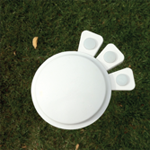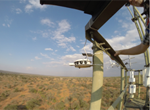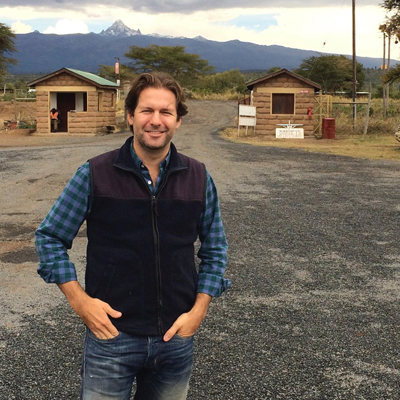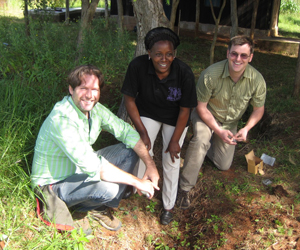When he was in elementary school, Kelly Caylor built a weather station in his parents’ backyard in Tallahassee, Florida. Decades later, he’s distributing high-tech environmental sensors, or “pods,” throughout sub-Saharan Africa. Unlike the DIY contraption he built as a student, these pods are sleek, smart, and sturdy enough to survive run-ins with tractors.
As an ecohydrologist at Princeton University, Caylor wants to understand how climate affects the ways farmers use their land, particularly in arid regions vulnerable to water shortages. His fieldwork involves communities in Kenya and Zambia that rely on subsistence farming for food and sustenance—and where environmental and weather data are in short supply.
In 2014, Caylor and his colleagues designed Pulsepod, a network of pods with mix-and-match environmental sensors that transmit data back to Princeton by cell phone. Once the team finishes its pilot testing, Caylor hopes Pulsepod will give researchers a better grasp of the complex relationships among water, soil, and plants in dryland ecosystems. Ultimately, the system should help growers better plan and manage their fields.
Caylor discussed this environmental monitoring system at the February 2015 meeting of the American Association for the Advancement of Science in San Jose. Afterward, SciCom’s Kerry Klein caught up with him to talk about pods, text messaging and digging up trees in Africa.
Editor's note: An abbreviated version of this conversation appeared online at Scientific American.
You are an ecohydrologist. What does that mean?
I'm interested in how water moves around landscapes and how it interacts with vegetation. That's borne out of my long-term interest in drylands, which are heavily influenced by the variability in water: how much it rains, how much water gets in the soil, and how much of that water plants can use to grow.
Why did you choose to study sub-Saharan Africa?
I got out there originally for my Ph.D. [from the University of Virginia in 2003]. I was studying forestry and we went to Malawi to work with forest service agents. I hadn't traveled much outside the U.S., and something kind of turned on and I really loved it.
What’s an early experience that left an impression?
I spent a lot of time in Botswana. We had a project trying to map the root systems of trees. You have to go up to people and say, "Hey, we're going to spend the next three months digging up trees, are any of you guys interested in that?” To actually have people who wanted to get involved was pretty remarkable. When I think about trying to convince my fellow Princeton residents to dig up some trees with me, it's a very hard sell.
Why are you now focusing on subsistence farming?
In a lot of communities, it's the dominant livelihood. It’s the fundamental basis of the economy, and yet the outcomes are extremely variable from farmer to farmer, from field to field. One of the challenges is that farmers don't have access to resources to buy more advanced machinery or more expensive seeds. That investment is hindered because of the lack of crop insurance; there's no crop insurance because there's no weather data. And if you don't have crop insurance, you can't go to a bank and ask for a loan because there's no guarantee of income. So there's a whole cascade of problems that arise fundamentally from not knowing much about what the weather's doing.
"There's a whole cascade of problems that arise fundamentally from not knowing much about what the weather's doing."
Where does Pulsepod come in?
Pulsepod is a low-cost system for taking environmental observations and communicating them over a cell phone system. You can monitor the environment and make decisions based on the data it collects.
What kinds of data do the pods collect?
Mostly information about weather and plants and soil. We measure weather through pretty traditional means. The simplest way to do wind speed is a cup anemometer. For rainfall, the simplest way is a funnel that gathers the rain and passes it over a little device that tips back and forth.
For the crops themselves, we're measuring aspects of their growth: How much light are the plants absorbing? Do they have sufficient nutrients? How warm are their leaves? If your eyes were able to see in the infrared, you might see a cool leaf; that coolness tells us about how much water the plant is using. If the leaf starts to warm up, we may learn whether or not it’s under stress. Some of the measurements we're taking are in visible light, but some are in the infrared.
What does an individual pod look like, and where do you put it in the field?
 It’s about the size of a smoke alarm. It can hold seven or eight different types of sensors. We're looking for something that's small, integrated, and where there's one button to make it as simple to use as possible.
It’s about the size of a smoke alarm. It can hold seven or eight different types of sensors. We're looking for something that's small, integrated, and where there's one button to make it as simple to use as possible.
 It’s sitting above the canopy on a pole, and it's looking down at the canopy and [measuring] how it's changing through time. You can get good measurements without having to be in contact with the leaves. If you're interested in something like soil moisture, the best way to measure that is to have a sensor that's embedded in the soil.
It’s sitting above the canopy on a pole, and it's looking down at the canopy and [measuring] how it's changing through time. You can get good measurements without having to be in contact with the leaves. If you're interested in something like soil moisture, the best way to measure that is to have a sensor that's embedded in the soil.
Where does the data go?
Right now the system is sending the data via SMS [Short Message Service, or text message], which is the most robust, secure, and reliable way of communication. And then we'll take that message and post it into our database.
Wow, I'm blown away that SMS is the easiest way to transmit this information.
Well, you've never gotten half an SMS, you know? It either comes through all the way or not. If a phone is on a network, it can send an SMS.
How many people in the communities you study tend to have cell phones?
In Kenya, something like 80% of all households. Most of those are not smartphones, but they can all receive texts. In fact, most Kenyans in the areas where I work do their banking on their cell phones. When I’m buying something with my credit card, I'm the guy holding up the line.
How often do pods send text messages?
They're pretty chatty. When we're testing them, we put them in a thing we call “teenager mode” where they send a text message like every minute. But in reality they text more at the rate of a faculty member, maybe just a few times per day.
So this data is going to you. Is it also going to the farmers?
We would like it to, eventually. But it's especially important, when we talk about Kenya and Zambia, that the information the farmers are receiving comes from the sources they already trust and work with. That tends to be the government. So we're working with government organizations to figure out the ways of getting that to the farmers so it'll be more relevant to their needs.
You’re saying the raw stream of data would not be useful to farmers?
Raw data is barely useful for researchers. You almost always have to do something with the data to figure out what it means. There's some data that the farmer may want right away; rainfall may not need much interpretation. But other things are more subtle. Think about a parent who has a sick child. You know your kid's sick because she’s lethargic, she’s acting cranky. You take her temperature, but the temperature itself doesn't tell you anything unless you have guidelines. If the temperature's 103 degrees, maybe we should go to the hospital. If it's 100 degrees, let's take some Tylenol.
In your talk, you emphasized that environmental monitoring is only one focal point of your research. The other is decision-making by the farmers. What kinds of decisions do you monitor?
We compare two types of decisions. A lot of the emphasis has been on where farmers plant, when they plant, and what they plant. Those are decisions farmers make at the beginning of a season. We don't really think much about what happens after that; the climate does its thing and at the end we get some crops, right? In reality, the farmer's making a lot of decisions about whether or not to weed, how to allocate labor across multiple fields, when to harvest, and all those intra-seasonal decisions. And so, if you're monitoring the environment through that season, you also need to monitor the decision-making that's happening through that season.
How do you do that?
When we put a pod in a field, we also enroll a farmer in a program where the farmer answers a weekly survey through SMS.
How much do pods cost?
We can make them now for a few hundred dollars [each]. That will probably go down as we get to larger scales.
How many pods have you installed?
We have about 70 pods, and those have collectively deployed about 200 times in Kenya, Zambia and the U.S.
What have you found so far?
Most of the learning right now is about what we've done wrong. We've got a system in which you plug in different sensors, so each one of those plugs becomes an opportunity for weather to intrude. Modularity turns out to not be an asset.
We thought power management would be a big problem, but when the pods can survive a heavy storm or get run over by a tractor, they tend to never lose power. You would've thought the tiny little solar panel would be the thing that fails. But it wasn't.
You’re doing all of this research within the backdrop of climate change. What’s the climate prognosis for sub-Saharan African drylands?
Variability is increasing. The difference between good years and bad years is getting larger. And intense rains followed by long periods without rain are becoming more common. Those things make it much harder to manage risk and uncertainty.
What’s your dream for how Pulsepod will help these agricultural regions advance?
The phrase that's used a lot is "climate-smart agriculture." It’s agriculture that's taking into account and embracing that variability so we can mitigate the impacts.
Certainly one of the most important things you need is data, and Pulsepod can provide data. It's not necessarily going to give you all the answers, and no data ever does, but it might help you understand what works, what doesn't work and how you can improve.
So you're optimistic.
You have to be optimistic, right? These problems are hard. They're almost impossible to solve as an individual, but they certainly can't be solved if you're not optimistic.
____________________
© 2015 Kerry Klein. Monitor SciCom graduate student Kerry Klein's work at kerryklein.com.
PulsePod photo credits: Adam Wolf


